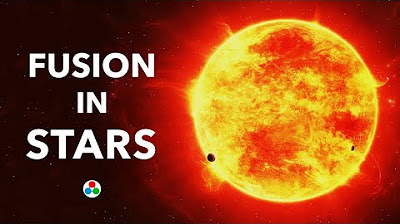Where Does The Sun Get Its Energy?
Summary
TLDRIn this engaging conversation, participants explore the science behind the Sun's energy production, delving into concepts like nuclear fusion, protons, and Einstein's famous equation, E=mc². They discuss how protons collide and fuse to form helium, releasing vast amounts of energy while losing mass in the process. The dialogue highlights the dynamic interaction of protons, the significance of temperature in fusion, and the continuous loss of mass from the Sun. With an emphasis on curiosity and learning, the discussion invites viewers to appreciate the complex yet fascinating nature of stellar processes.
Takeaways
- ☀️ The Sun provides heat and energy, which are essential for life on Earth.
- 🌌 The Sun's energy originates from nuclear fusion, where protons collide at high speeds.
- 💥 Protons bounce off each other due to their positive charge, requiring high temperatures to overcome this repulsion.
- ⚛️ When protons collide, they can fuse together, releasing energy in the process.
- 🔄 The mass lost during fusion is converted into energy, demonstrating Einstein's equation E=mc².
- 🌡️ The Sun loses approximately 4.3 billion kilograms of mass every second as it converts mass into energy.
- 🔬 Hydrogen in the Sun fuses to create helium, emitting positrons and neutrinos during the process.
- 🧪 The fusion process is facilitated by the vast amount of hydrogen in the Sun, allowing for frequent collisions.
- 🤔 Many people struggle to remember that 'C' in E=mc² represents the speed of light, which is a fundamental constant.
- 🎥 For deeper understanding, the script references additional educational resources like Minute Physics on fusion.
Q & A
What is the primary source of energy for the Sun?
-The primary source of energy for the Sun is nuclear fusion, where hydrogen nuclei (protons) fuse to form helium, releasing energy in the process.
Why do protons repel each other?
-Protons repel each other because they are positively charged. According to electromagnetic theory, like charges repel each other.
What conditions are necessary for protons to fuse in the Sun?
-High temperatures and pressures are necessary for protons to overcome their electrostatic repulsion and collide with enough energy to fuse together.
How much mass does the Sun lose every second?
-The Sun loses approximately 4.3 billion kilograms of mass every second as a result of the fusion process converting mass into energy.
What does Einstein's equation E=mc² represent in the context of the Sun?
-Einstein's equation E=mc² illustrates the relationship between mass and energy, indicating that a small amount of mass can be converted into a large amount of energy, which is fundamental to the Sun's energy production.
What happens to protons during the fusion process?
-During the fusion process, some protons emit positrons and neutrinos and convert into neutrons, which allows the formation of helium nuclei.
What is the significance of the speed of light (c) in the equation E=mc²?
-In the equation E=mc², the speed of light (c) is squared, indicating that even a tiny amount of mass can be converted into a tremendous amount of energy due to the large value of c.
What role do neutrons play in the Sun's fusion process?
-Neutrons formed during fusion help stabilize the helium nucleus, allowing it to exist alongside protons in the fusion process.
How does the Sun maintain the necessary conditions for fusion?
-The Sun maintains the necessary conditions for fusion through its immense gravitational pressure and high core temperatures, which result from its large mass.
What educational resources are suggested for learning more about fusion in the Sun?
-The video suggests checking out additional resources, such as Minute Physics, which explains the fusion process and how protons can overcome their repulsion to fuse.
Outlines

This section is available to paid users only. Please upgrade to access this part.
Upgrade NowMindmap

This section is available to paid users only. Please upgrade to access this part.
Upgrade NowKeywords

This section is available to paid users only. Please upgrade to access this part.
Upgrade NowHighlights

This section is available to paid users only. Please upgrade to access this part.
Upgrade NowTranscripts

This section is available to paid users only. Please upgrade to access this part.
Upgrade NowBrowse More Related Video

Nuclear Chemistry Part 2 - Fusion and Fission: Crash Course Chemistry #39

How Stars Turn MATTER into ENERGY | Nuclear Fusion

IGCSE Physics (2023-2025) - C22/25: The Nuclear Atom

How the Sun Shines: The Nuclear Reactions that Power the Sun

Teoria da Relatividade Especial ou Restrita - Brasil Escola

El Sol NO Debería Brillar
5.0 / 5 (0 votes)